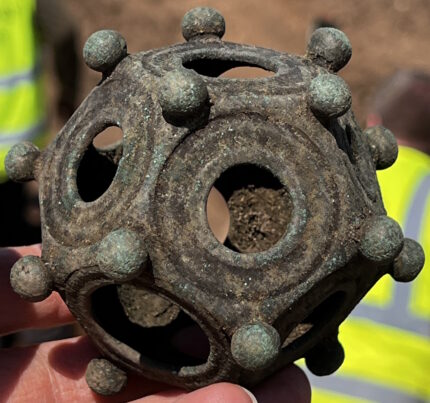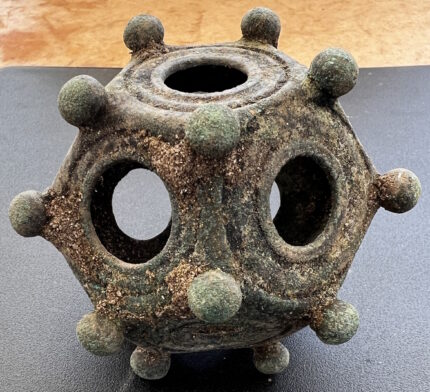An unusually large and fine example of the mysterious Roman dodecahedron has been unearthed in a community dig at Norton Disney in Lincolnshire. Only about 130 of these hollow 12-sided copper alloy objects have been found in the no rthern and western provinces of the Roman Empire. This is only the 33rd example found in England. None have been found in Rome, and there are no references to them in the ancient sources, inscriptions, frescoes, mosaics or any other medium to explain their purpose or function.
rthern and western provinces of the Roman Empire. This is only the 33rd example found in England. None have been found in Rome, and there are no references to them in the ancient sources, inscriptions, frescoes, mosaics or any other medium to explain their purpose or function.
The dodecahedron was discovered last summer in an excavation at Potter Hill. It was in a pit, perhaps a quarry pit, filled with Roman pottery fragments and demolition rubble. It weighs 250 grams, is 8 cm (3.1 inches) wide, significantly larger than average, and 100% complete. As rare as these objects are, even more rare is to discover them in situ where they were originally buried in an organized archaeological dig. Most of them are in private collections and museums (or in a looter stash) and all information about their original contexts is lost.
A Roman villa was discovered less than a half mile away from Potter Hill in 1933. It was near the Fosse Way, a major Roman road that connected Exeter to Lincoln. The remains of the villa, entirely underground today, are on the National Heritage List. (Unfortunately, the villa is also on Historic England’s “Heritage At Risk” register, not because of human interference, but due to a community of badgers, who are themselves protected, having dug a sett amidst the ruins.) It’s possible the pit where the dodecahedron was found was associated with the villa or another high-status building.
 There are many theories about what the Gallo-Roman dodecahedra were used for — candle holders, surveyor’s tools, wool crafts — but no consistent wear patterns attest to any such practical usage. X-ray fluorescence analysis of the Norton Disney dodecahedron found it is 67% copper, 7% tin and 26% lead. That is a high proportion of lead, a soft and malleable metal very prone to squishing, for a tool. They are all different sizes, ranging from golf ball to baseball, and have holes of different sizes in each of the 12 hexagonal sides. The overall design is consistent, however, with ball-shaped studs at each corner of the sides. In the end, the old fallback of “ritual purpose” seems to be the likeliest possibility.
There are many theories about what the Gallo-Roman dodecahedra were used for — candle holders, surveyor’s tools, wool crafts — but no consistent wear patterns attest to any such practical usage. X-ray fluorescence analysis of the Norton Disney dodecahedron found it is 67% copper, 7% tin and 26% lead. That is a high proportion of lead, a soft and malleable metal very prone to squishing, for a tool. They are all different sizes, ranging from golf ball to baseball, and have holes of different sizes in each of the 12 hexagonal sides. The overall design is consistent, however, with ball-shaped studs at each corner of the sides. In the end, the old fallback of “ritual purpose” seems to be the likeliest possibility.
The dodecahedron went on display at the National Civil War Centre in Newark-on-Trent on January 3rd and is already drawing crowds. It was also featured on the January 9th episode of the long-lived BBC series Digging for Britain. The episode can be viewed here but only from UK IP addresses.
The Norton Disney History and Archaeology Group is raising funds for a follow-up excavation of the find site this summer. The team was not able to finish their excavations of trenches three and four, so they need to go back to pick up where they left off. They have a very modest of goal of £1,000 and have raised £155 of it so far. To contribute to their efforts, donate here.
You can get a great view of its unusual size and excellent condition in this short video:
Want to see the Norton Disney dodecahedron then you can? Drop by @civilwarcentre in Newark. https://t.co/mnrrdsqaKU pic.twitter.com/vwhqy5LvXr
— Norton Disney History + Archaeology Group (@ndhags) January 11, 2024